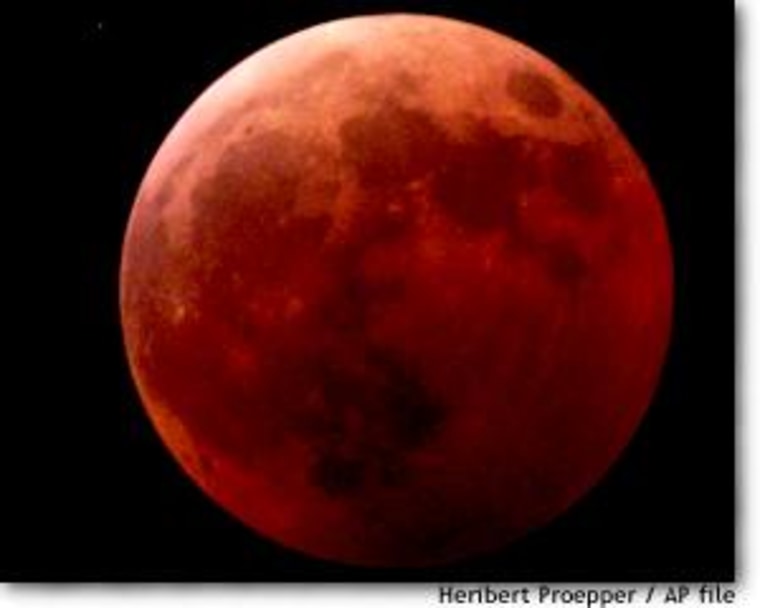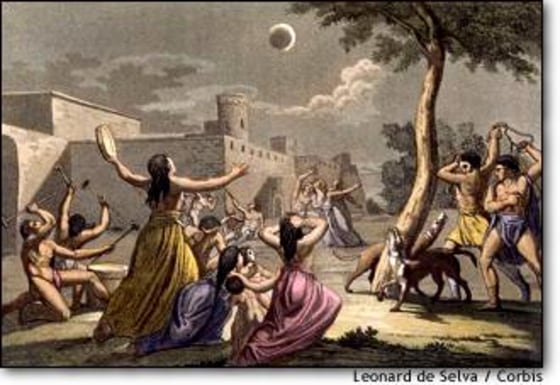The second chance to see a total lunar eclipse in 2003 comes this weekend for most residents of North America and Europe. Two more in 2004 will round out this current spate of lunar disappearances. Then there will be a nearly three-year drought. What’s going on? What causes an eclipse, and why do they occur on an irregular schedule?
Unpredictability is at the heart of eclipse lore. For the ancients, a lunar eclipse was a haunting event. Some believed a dragon of the sky was eating the moon, flooding it with blood before consuming it entirely. Of course it always came back, and that fueled more speculation.
Here are 10 cool facts about the dark history of lunar eclipses and how they really work.
1. Earth gets in the way:
The cause of lunar eclipses is simple: Earth gets in the way.
The moon is a visible beacon because it reflects sunlight. The moon makes no light of its own. Earth always casts a shadow into space, and every now and then everything aligns just right so that the shadow falls on the moon.
Lunar eclipses can only occur at full moon, that time each month when the moon is directly opposite Earth in relation to the sun. It’s like you, representing Earth, standing in front of a bright light and casting a shadow on a child.
This week’s total lunar eclipse occurs Saturday evening in North and South America, which is early Sunday morning for Europe and Africa.
2. Why lunar eclipses don’t occur every month:
Since lunar eclipses occur always at full moon, it makes sense to ask why each Full Moon does not generate an eclipse.
Eclipses are relatively rare because the plane in which the moon orbits around Earth is tilted 5 degrees compared to the plane of Earth’s travels around the Sun, a plane that astronomers call the ecliptic.
To visualize, think of commingling Hula Hoops floating on the surface of a pool, and push one down so that half of it is below the surface and half above.
When the moon gets into the ecliptic — right at the surface of the pool — during its full phase, then a lunar eclipse occurs. (The word “ecliptic” stems from the word “eclipse.”)
The geometry of any eclipse — the relative positions of the sun, Earth and moon — is eventually repeated during a set of complex cycles that each last just more than 18 years. This Saros cycle, as the whole thing is called, is behind the bunching of eclipses, too. Astronomers have figured it out and can predict eclipse timing and circumstances far into future.
3. Lunar eclipses are frequent, relatively speaking:
Though you might not have logged many lunar eclipses in your life, they are common, compared with solar eclipses, at least in one sense.
Solar eclipses are fairly numerous, generally two to five per year, but the area on the ground covered by totality is only a few tens of miles (kilometers) wide, so it’s rare to be in the path of a total solar eclipse. In any given location on Earth, a total solar eclipse happens only once every 360 years.
Lunar eclipses are less frequent, but total lunar eclipses are visible everywhere that it is nighttime as the event takes place — essentially half the globe.
Any given location can experience up to three lunar eclipses per year, as last happened in 1982. Some years there are none.
4. Eclipses are visible from the moon, too:
When Earth experiences a total lunar eclipse, things get interesting on the moon as well.
If you were there, on the side facing Earth, the home planet would block out the sun. The sun’s light would not completely disappear, however. Earth would be ringed by light scattered through its atmosphere.
Space.com’s Night Sky columnist, Joe Rao, puts it this way, “The sun would be hidden behind a dark Earth outlined by a brilliant red ring consisting of all the world’s sunrises and sunsets.”
The light refracted by all these sunrises and sunsets can fall on the moon, giving it a red glow instead of it completely disappearing. Each eclipse is different, however, and some yield little of this reddening effect.

5. A bite out of the moon:
For ancient people, eclipses were odd and inexplicable, even terrifying. Some cultures saw lunar eclipses as signs of celestial wrath that portended famine or disease.
The Chinese word for eclipse is chih, which means “to eat.” One can imagine that the bloody cast of the moon in some eclipses only added to the fear of what was going on. Even into the 19th century, the Chinese navy fired cannons to scare off the dragon they imagined was eating the moon.
6. Myths persist today:
Myths die hard. In Japan, some people still cover wells to avoid being poisoned by the disease of the moon during an eclipse. Native residents of Arctic regions are known to turn over their utensils to avoid contamination.
In other cultures, people yell at the moon during an eclipse, or they bang pots or even shoot into the air.
7. Stonehenge may have predicted eclipses:
The mysterious arrangement of boulders in England has long been associated with celestial meaning. But scientists have struggled to figure out what the meaning was for the folks who erected the rocks about 3,500 years ago.
One purpose may have been to predict lunar eclipses.
In the year 2000, a researcher who had been studying Stonehenge for two decades stumbled upon the observation that if a person placed stone markers at strategic locations atop 19 columns in the array, a known 47-month cycle of lunar eclipses would become apparent.
8. Eclipses changed history:
When the moon disappeared in 413 B.C., Athenians saw it as a bad omen and delayed their planned retreat from the Sicilian city of Syracuse, where they had fought for two years in the Peloponnesian War.
The Syracusans used the delay as an opportunity to break the siege, contributing — some believe — to the fall of Greek civilization.
Christopher Columbus actually used an eclipse knowingly to perhaps alter history.
Stranded in Jamaica in 1503, on his fourth voyage, Columbus and his crew were wearing out their welcome with the natives, who were feeding them. Columbus knew a lunar eclipse was coming, so he predicted the moon’s disappearance. The natives begged him to bring it back and, of course, he did, in due time.
9. Eclipse time limits:
Columbus knew that lunar eclipses don’t go on forever. Astronomers say none can last more than 3 hours and 40 minutes. Totality cannot run more than 1 hour and 40 minutes.
The period of totality for the Nov. 8-9 eclipse will be just 25 minutes.
An eclipse on May 4, 2004 — best visible in Europe — will have a period of totality of 1 hour and 16 minutes.
Why the difference? Earth’s shadow is cone-shaped. Envision a slice of it, a two-dimensional circle through which the moon can pass. Longer stretches of totality mean the moon is traversing the center of the circle. Shorter total eclipses occur when the moon’s path is nearer the top or the bottom of the shadow.
10. The moon’s name:
Full moons have all sorts of names that have been passed down from ancient (and sometimes more modern) cultures. Many of the names common in North America come from Native American traditions, others were imported from Europe.
November’s full moon is called the Beaver Moon by others (since, presumably, beavers are actively preparing for winter). There are other names.
And in this sense, every eclipse has a name, too. You can, by another tradition, call this the Frosty Eclipse. Weather permitting, you’ll get to see it and, if tradition is any guide, you’ll want to dress warmly.
Portions of this article were first published prior to the May 15 total lunar eclipse.
